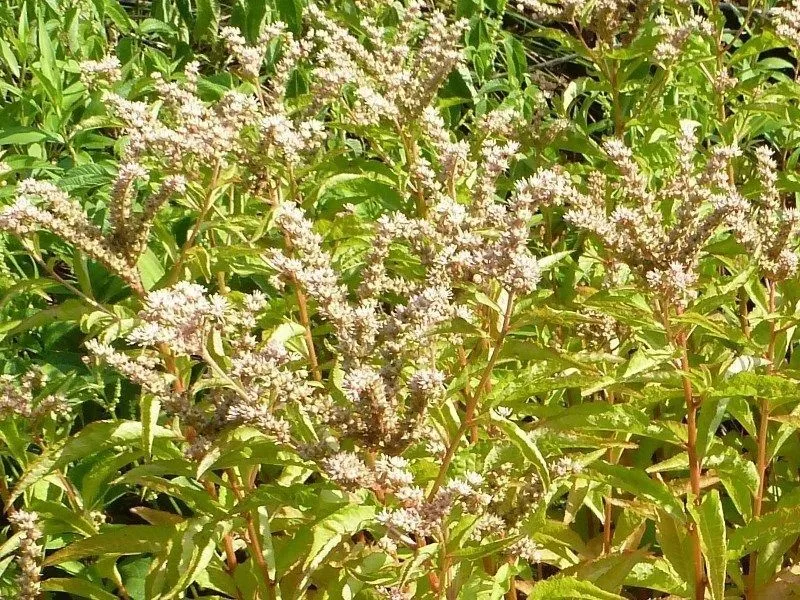
Author: L.
Bibliography: Sp. Pl.: 432 (1753)
Year: 1753
Status: accepted
Rank: species
Genus: Penthorum
Vegetable: False
Observations: C. & E. Canada to C. & E. U.S.A.
Ditch-stonecrop (Penthorum sedoides) is a perennial herbaceous plant that belongs to the family Penthoraceae. Its natural range extends across central and eastern regions of Canada and the United States, making it a common sight in these areas. The species was first described in 1753 by the renowned botanist Carl Linnaeus, which is documented in the seminal work “Species Plantarum.”
This intriguing plant is often found in wet habitats such as marshes, ditches, and the edges of ponds and streams. The name “ditch-stonecrop” aptly reflects its preference for these damp, low-lying environments. Ditch-stonecrop typically grows to a height of about 30 to 60 cm, with upright, branching stems that are sometimes tinged with red. The leaves are alternately arranged along the stems and are generally oblong to lanceolate in shape, with finely toothed margins.
One of the distinctive features of Penthorum sedoides is its flowering structure. The small, star-shaped flowers, which appear in late summer to early fall, are clustered in terminal cymes. Each flower has five yellowish-green sepals but lacks true petals, giving it a somewhat understated appearance. Following flowering, the plant produces small, woody, star-like seed capsules that persist into the late fall and winter, contributing to its unique visual interest in the landscape.
In addition to its ornamental value, ditch-stonecrop plays a role in its ecosystem by providing habitat and food for various wetland and aquatic insects. Its presence can be an indicator of a healthy wetland environment, as it thrives in undisturbed, natural conditions.
Gardeners and nature enthusiasts might cultivate ditch-stonecrop in water gardens or around the edges of ponds to take advantage of its hardiness and unique aesthetic. However, its preference for moist, boggy soils must be considered, as it is not well-suited to dry or upland areas.
Overall, Penthorum sedoides is a plant that not only enhances the biodiversity of wetland habitats but also offers an interesting subject for botanical study and observation, reflecting the rich flora of North American wetlands.
Eng: ditch stonecrop, ditch-stonecrop, virginia penthorum, virginia stonecrop
Fra: penthorum faux-orpin
En: Ditch-stonecrop, Ditch stonecrop, VIRGINIA PENTHORUM, Virginia stonecrop
Fr: Penthorum faux-orpin
Taken Oct 2, 2020 by le vide hecke (cc-by-sa)
Taken Jun 22, 2022 by Elize Finne (cc-by-sa)
Taken Sep 29, 2019 by Whitney Dunlap (cc-by-sa)
Taken Jul 22, 2014 by EOL − Christopher Tracey (cc-by-nc-sa)
Taken Jan 1, 1900 by EOL − John Hilty (cc-by-nc)
Taken Sep 14, 2013 by EOL − dsuarez (cc-by-nc)
Taken Nov 20, 2014 by EOL − Matt Rung (cc-by-nc)
Taken Jan 1, 1900 by EOL − John Hilty (cc-by-nc)
Taken Dec 20, 2015 by EOL − Robert L Curtis (cc-by-nc-sa)
Taken Jun 15, 1996 by EOL − Darel Hess (cc-by-nc-sa)
© copyright of the Board of Trustees of the Royal Botanic Gardens, Kew.
Taken Jul 25, 2021 by Sarah Cornell (cc-by-sa)
Taken Aug 25, 2013 by EOL − Ron Edwards (cc-by-nc)
Taken Feb 14, 2015 by EOL − scottmohan (cc-by-nc)
Taken Jul 25, 2014 by EOL − Daniel Carter (cc-by-nc)
Taken Sep 15, 2013 by EOL − Erin Faulkner (cc-by-nc)
Taken Jun 15, 1996 by EOL − Darel Hess (cc-by-nc-sa)
Taken Jan 1, 1900 by EOL − John Hilty (cc-by-nc)
Taken Jan 1, 1900 by EOL − John Hilty (cc-by-nc)
Growth form>: Stoloniferous
Growth habit>: Forb/herb
Growth rate>: Slow
Ph maximum: 7.0
Ph minimum: 5.0
Family: Myrtaceae Author: (F.Muell.) K.D.Hill & L.A.S.Johnson Bibliography: Telopea 6: 402 (1995) Year: 1995 Status:…
Family: Rubiaceae Author: Pierre ex A.Froehner Bibliography: Notizbl. Bot. Gart. Berlin-Dahlem 1: 237 (1897) Year:…
Family: Sapindaceae Author: Koidz. Bibliography: J. Coll. Sci. Imp. Univ. Tokyo 32(1): 38 (1911) Year:…
Family: Asteraceae Author: A.Gray Bibliography: Pacif. Railr. Rep.: 107 (1857) Year: 1857 Status: accepted Rank:…
Family: Fabaceae Author: Medik. Bibliography: Vorles. Churpfälz. Phys.-Ökon. Ges. 2: 398 (1787) Year: 1787 Status:…
Family: Aspleniaceae Author: (Cav.) Alston Bibliography: Bull. Misc. Inform. Kew 1932: 309 (1932) Year: 1932…